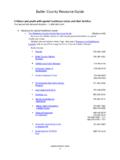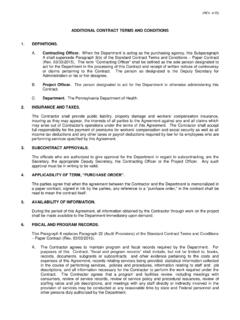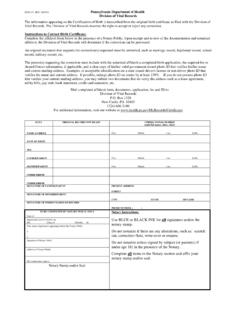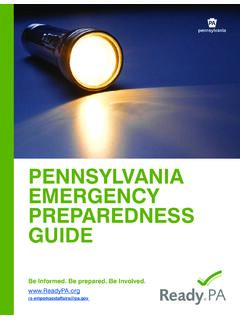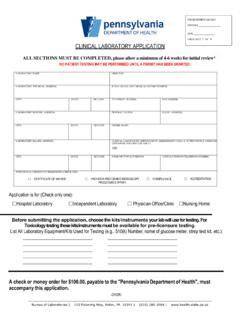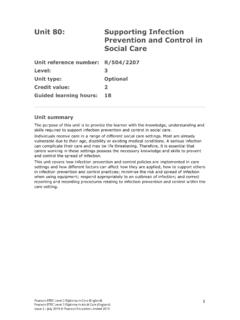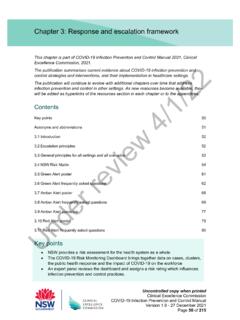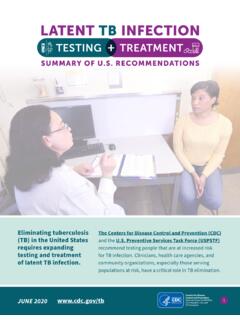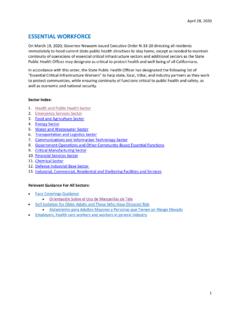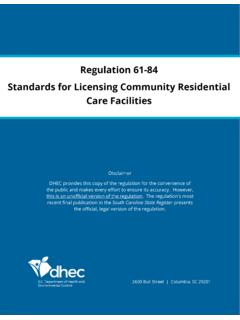Transcription of PENNSYLVANIA DEPARTMENT OF HEALTH Please refer to PA …
1 Page 1 of 14 Update # 597 PENNSYLVANIA DEPARTMENT OF HEALTH 2021 PAHAN 597 09-21-UPD UPDATE: Interim Infection prevention and control Recommendations for Healthcare Settings during the COVID-19 Pandemic DATE: 9/21/2021 TO: HEALTH Alert Network FROM: Alison Beam, JD, Acting Secretary of HEALTH SUBJECT: UPDATE: Interim Infection prevention and control Recommendations for Healthcare Settings during the COVID-19 Pandemic DISTRIBUTION: Statewide LOCATION: n/a STREET ADDRESS: n/a COUNTY: n/a MUNICIPALITY: n/a ZIP CODE: n/a This transmission is a HEALTH Update : provides updated information regarding an incident or situation; unlikely to require immediate action. HOSPITALS: Please SHARE WITH ALL MEDICAL, PEDIATRIC, NURSING AND LABORATORY STAFF IN YOUR HOSPITAL; EMS COUNCILS: Please DISTRIBUTE AS APPROPRIATE; FQHCs: Please DISTRIBUTE AS APPROPRIATE LOCAL HEALTH JURISDICTIONS: Please DISTRIBUTE AS APPROPRIATE; PROFESSIONAL ORGANIZATIONS: Please DISTRIBUTE TO YOUR MEMBERSHIP; LONG-TERM CARE FACILITIES: Please SHARE WITH ALL MEDICAL, INFECTION control , AND NURSING STAFF IN YOUR FACILITY This HAN Update provides comprehensive information regarding infection prevention and control for COVID-19 in healthcare settings based on changes made by CDC on September 10, content of this HAN has been re-organized to more closely align with the formatting of CDC guidance, but contains similar content to previously available HANs.
2 This update replaces PA-HAN-563, PA-HAN-554, PA-HAN-544 and PA-HAN-521. Major additions and edits in this version include: Added options for fully vaccinated persons to forgo source control in limited situations in healthcare facilities in counties with low to moderate community transmission. Removed quarantine recommendations for fully vaccinated patients who have had close contact with someone with SARS-CoV-2 infection, in most circumstances. An emphasis remains on testing and source control for these patients for 14 days following exposure. Clarification of the recommended intervals for testing asymptomatic persons following exposure to someone with SARS-CoV-2 infection. Compiled several healthcare guidance documents, including guidance for dental settings (PA-HAN-521), hospital outbreak response (PA-HAN-544) and the discontinuation of Transmission-based Precautions for COVID-19 (PA-HAN-554).
3 If you have additional questions about this guidance, Please contact DOH at 1-877-PA- HEALTH (1-877-724-3258) or your local HEALTH DEPARTMENT . This document has been archived. Please refer to PA-HAN-624 for updated information on the topic. Page 2 of 14 Update # 597 This guidance has been updated based on currently available information about COVID-19 and the current situation in PENNSYLVANIA . It applies to all persons regardless of COVID-19 vaccination status, unless otherwise indicated. This HAN replaces PA-HAN-563, PA-HAN-554, PA-HAN-544, and PA-HAN-521. If you have questions about this guidance, Please contact DOH at 1-877-PA- HEALTH (1-877-724-3258) or your local HEALTH DEPARTMENT . This guidance is not intended for non-healthcare settings ( , schools) OR for persons outside of healthcare settings. Defining Community Transmission of SARS-CoV-2 Several of the IPC measures ( , use of source control , screening testing) are influenced by levels of SARS-CoV-2 transmission in the community.
4 Two different indicators in CDC s COVID-19 Data Tracker are used to determine the level of SARS-CoV-2 transmission for the county where the healthcare facility is located. If the two indicators suggest different transmission levels, the higher level of community transmission should be selected. 1. RECOMMENDED ROUTINE INFECTION prevention AND control (IPC) PRACTICES DURING THE COVID-19 PANDEMIC DOH recommends using the following additional infection prevention and control practices during the COVID-19 pandemic, along with standard practices recommended as a part of routine healthcare delivery to all patients. These practices are intended to apply to all patients, not just those with suspected or confirmed SARS-CoV-2 infection (See Section 2 for additional practices that should be used when caring for patients with suspected or confirmed SARS-CoV-2 infection).
5 A. Establish a Process to Identify and Manage Individuals with Suspected or Confirmed SARS-CoV-2 Infection Ensure everyone is aware of recommended IPC practices in the facility. o Post visual alerts ( , signs, posters) at the entrance and in strategic places ( , waiting areas, elevators, cafeterias) with instructions about current IPC recommendations ( , when to use source control and perform hand hygiene). Dating these alerts can help ensure people know that they reflect current recommendations. Establish a process to identify anyone entering the facility, regardless of their vaccination status, who has any of the following so that they can be properly managed: 1) A positive viral test for SARS-CoV-2; 2) Symptoms of COVID-19, or 3) Who meets criteria for quarantine or exclusion from work. Options could include (but are not limited to): individual screening on arrival at the facility; or implementing an electronic monitoring system in which individuals can self-report any of the 3 above criteria before entering the facility.
6 Healthcare personnel (HCP), even if fully vaccinated, should report any of the 3 above criteria to occupational HEALTH or another point of contact designated by the facility. Recommendations for evaluation and work restriction of these HCP are in PA-HAN-596. Visitors meeting any of the 3 above criteria should generally be restricted from entering the facility until they have met criteria to end isolation or quarantine, respectively. Additional information about visitation for nursing homes and intermediate care facilities for individuals with intellectual disabilities and psychiatric residential treatment facilities is available from CMS. Patients meeting any of the three above criteria should be managed as described in Section 2. Page 3 of 14 Update # 597 Unvaccinated HCP, patients and visitors should be offered resources and information about the importance of receiving the COVID-19 vaccine.
7 B. Implement Source control Measures Source control refers to use of respirators or well-fitting facemasks or cloth masks to cover a person s mouth and nose to prevent spread of respiratory secretions when they are breathing, talking, sneezing or coughing. Source control options for HCP include: o A NIOSH-approved N95 or equivalent or higher-level respirator, o A respirator approved under standards used in other countries that are similar to NIOSH-approved N95 filtering facepiece respirators (note: these should not be used instead of a NIOSH-approved respirator when respiratory protection is indicated), OR o A well-fitting facemask. When used solely for source control , any of the options listed above could be used for an entire shift unless they become soiled, damaged or hard to breathe through. If they are used during the care of patient for which a NIOSH-approved respirator or facemask is indicated for personal protective equipment (PPE) ( , NIOSH-approved N95 or equivalent or higher-level respirator during the care of a patient with SARS-CoV-2 infection, facemask during a surgical procedure or during care of a patient on Droplet Precautions), they should be removed using proper doffing technique and discarded after the patient care encounter and a new one should be donned.
8 Source control and physical distancing (when physical distancing is feasible and will not interfere with provision of care) are recommended for everyone in a healthcare setting. This is particularly important for individuals, regardless of their vaccination status, who live or work in counties with substantial to high community transmission or who have: Not been fully vaccinated; Suspected or confirmed SARS-CoV-2 infection or other respiratory infection ( , those with runny nose, cough, sneeze); Are fully vaccinated but had close contact (patients and visitors) or a higher-risk exposure (for HCP; per PA-HAN-596) with someone with SARS-CoV-2 infection for 14 days after their exposure, including those residing or working in areas of a healthcare facility experiencing SARS-CoV-2 transmission ( , outbreak); Moderate to severe immunocompromise; or Otherwise had source control and physical distancing recommended by public HEALTH authorities.
9 While it is generally safest to implement universal use of source control for everyone in a healthcare setting, the following allowances could be considered for fully vaccinated individuals (who do not otherwise meet the criteria described above) in healthcare facilities located in counties with low to moderate community transmission. Fully vaccinated people might choose to continue using source control if they or someone in their household is immunocompromised or at increased risk for severe disease, or if someone in their household is unvaccinated. Fully Vaccinated HCP in Areas of Low to Moderate Transmission: o Consistent with guidance for the community could choose to not wear source control or physically distance when they are in well-defined areas that are restricted from patient access, if consistent with the policy of the facility ( , staff meeting rooms, kitchen).
10 Page 4 of 14 Update # 597 They should wear source control when they are in areas of the healthcare facility where they could encounter patients ( , hospital cafeteria, common halls/corridors or reception desks, even if patients aren t there at the time). Patient Visitation in Areas of Low to Moderate Transmission: o Indoor visitation (in single-person rooms; in multi-person rooms when roommates are not present; or in designated visitation areas when others are not present): The safest practice is for patients and visitors to wear source control and physically distance, particularly if either the patient or the visitors are at risk for severe disease or are unvaccinated. If the patient and all their visitor(s) are fully vaccinated, they can choose not to wear source control and to have physical contact. Visitors should wear source control when around other patients or HCP, regardless of vaccination status.
